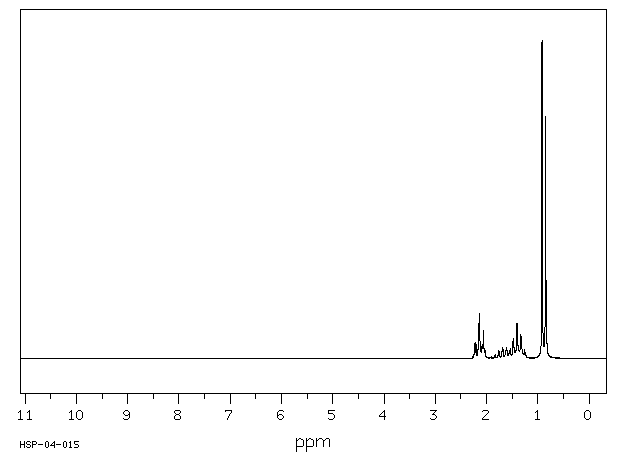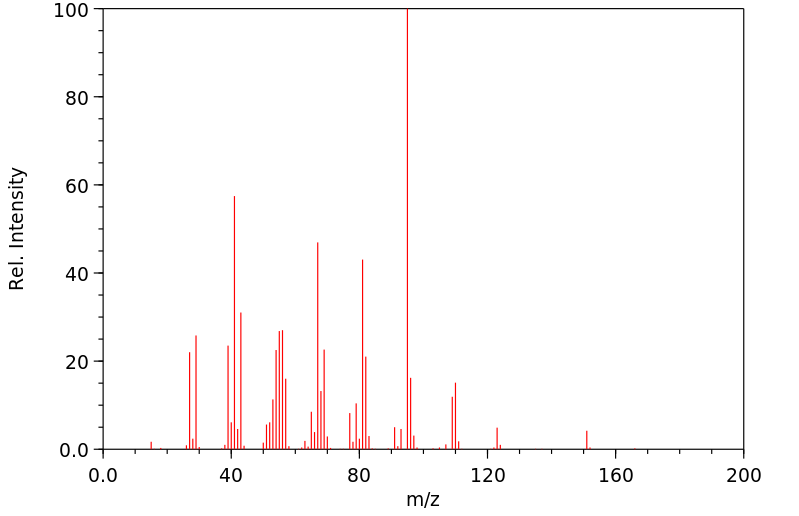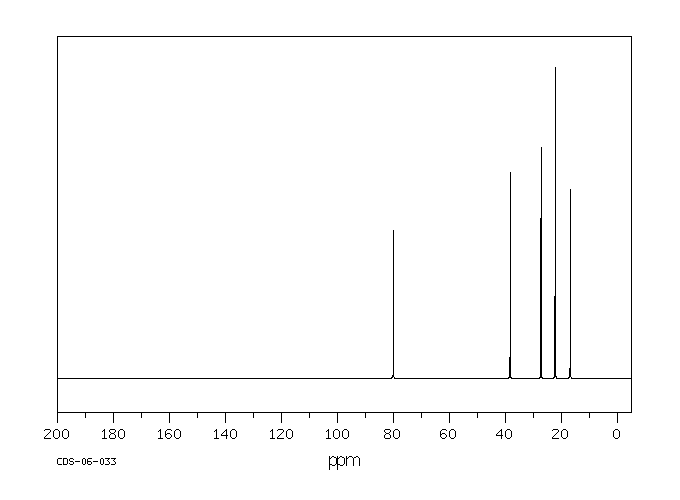2,9-二甲基-5-癸炔 | 19550-56-2
中文名称
2,9-二甲基-5-癸炔
中文别名
2,4,4',5-四氯联苯醚
英文名称
2,9-dimethyl-5-decyne
英文别名
2,9-dimethyldec-5-yne
CAS
19550-56-2
化学式
C12H22
mdl
MFCD00041611
分子量
166.307
InChiKey
RCFYJIGZQAOTFV-UHFFFAOYSA-N
BEILSTEIN
——
EINECS
——
-
物化性质
-
计算性质
-
ADMET
-
安全信息
-
SDS
-
制备方法与用途
-
上下游信息
-
文献信息
-
表征谱图
-
同类化合物
-
相关功能分类
-
相关结构分类
物化性质
-
沸点:91,9°C 19mm
-
密度:0,781 g/cm3
计算性质
-
辛醇/水分配系数(LogP):5
-
重原子数:12
-
可旋转键数:4
-
环数:0.0
-
sp3杂化的碳原子比例:0.833
-
拓扑面积:0
-
氢给体数:0
-
氢受体数:0
安全信息
-
海关编码:2901299090
-
储存条件:| 室温 |
SDS
2,9-二甲基-5-癸炔 修改号码:5
模块 1. 化学品
产品名称: 2,9-Dimethyl-5-decyne
修改号码: 5
模块 2. 危险性概述
GHS分类
物理性危害 未分类
健康危害
吸入性危害物质 第1级
环境危害 未分类
GHS标签元素
图标或危害标志
信号词 危险
危险描述
若吞咽并进入呼吸道可能致命
防范说明
[急救措施] 食入:立即呼叫解毒中心/医生。切勿催吐。
[储存] 存放处须加锁。
[废弃处置] 根据当地政府规定把物品/容器交与工业废弃处理机构。
模块 3. 成分/组成信息
单一物质/混和物 单一物质
化学名(中文名): 2,9-二甲基-5-癸炔
百分比: >95.0%(GC)
CAS编码: 19550-56-2
分子式: C12H22
模块 4. 急救措施
吸入: 将受害者移到新鲜空气处,保持呼吸通畅,休息。若感不适请求医/就诊。
皮肤接触: 立即去除/脱掉所有被污染的衣物。用水清洗皮肤/淋浴。
若皮肤刺激或发生皮疹:求医/就诊。
2,9-二甲基-5-癸炔 修改号码:5
模块 4. 急救措施
眼睛接触: 用水小心清洗几分钟。如果方便,易操作,摘除隐形眼镜。继续清洗。
如果眼睛刺激:求医/就诊。
食入: 立即呼叫解毒中心/医生。漱口。切勿引吐。
紧急救助者的防护: 救援者需要穿戴个人防护用品,比如橡胶手套和气密性护目镜。
模块 5. 消防措施
合适的灭火剂: 干粉,泡沫,二氧化碳
不适用的灭火剂: 水(有可能扩大灾情。)
特定方法: 从上风处灭火,根据周围环境选择合适的灭火方法。
非相关人员应该撤离至安全地方。
周围一旦着火:喷水,保持容器冷却。如果安全,消除一切火源。
消防员的特殊防护用具: 灭火时,一定要穿戴个人防护用品。
模块 6. 泄漏应急处理
个人防护措施,防护用具, 使用特殊的个人防护用品(自携式呼吸器)。远离溢出物/泄露处并处在上风处。确保
紧急措施: 足够通风。
泄露区应该用安全带等圈起来,控制非相关人员进入。
环保措施: 防止进入下水道。
控制和清洗的方法和材料: 用合适的吸收剂(如:旧布,干砂,土,锯屑)吸收泄漏物。一旦大量泄漏,筑堤控
制。附着物或收集物应该立即根据合适的法律法规废弃处置。
模块 7. 操作处置与储存
处理
技术措施: 在通风良好处进行处理。穿戴合适的防护用具。防止烟雾产生。处理后彻底清洗双手
和脸。
注意事项: 如果可能,使用封闭系统。如果蒸气或浮质产生,使用通风、局部排气。
操作处置注意事项: 避免接触皮肤、眼睛和衣物。
贮存
储存条件: 保持容器密闭。存放于凉爽、阴暗处。
存放处须加锁。
远离不相容的材料比如氧化剂存放。
包装材料: 依据法律。
模块 8. 接触控制和个体防护
工程控制: 尽可能安装封闭体系或局部排风系统。同时安装淋浴器和洗眼器。
个人防护用品
呼吸系统防护: 半面罩或全面罩呼吸器,自携式呼吸器(SCBA),供气呼吸器等。依据当地和政府法
规,使用通过政府标准的呼吸器。
手部防护: 防渗手套。
眼睛防护: 护目镜。如果情况需要,佩戴面具。
皮肤和身体防护: 防渗防护服。如果情况需要,穿戴防护靴。
模块 9. 理化特性
液体
外形(20°C):
外观: 透明
颜色: 无色-浅黄色
气味: 无资料
pH: 无数据资料
熔点: 无资料
2,9-二甲基-5-癸炔 修改号码:5
模块 9. 理化特性
沸点/沸程 92 °C/2.5kPa
闪点: 无资料
爆炸特性
爆炸下限: 无资料
爆炸上限: 无资料
密度: 0.77
溶解度:
[水] 无资料
[其他溶剂] 无资料
模块 10. 稳定性和反应性
化学稳定性: 一般情况下稳定。
危险反应的可能性: 未报道特殊反应性。
须避免接触的物质 氧化剂
危险的分解产物: 一氧化碳, 二氧化碳
模块 11. 毒理学信息
急性毒性: 无资料
对皮肤腐蚀或刺激: 无资料
对眼睛严重损害或刺激: 无资料
生殖细胞变异原性: 无资料
致癌性:
IARC = 无资料
NTP = 无资料
生殖毒性: 无资料
模块 12. 生态学信息
生态毒性:
鱼类: 无资料
甲壳类: 无资料
藻类: 无资料
残留性 / 降解性: 无资料
潜在生物累积 (BCF): 无资料
土壤中移动性
log水分配系数: 无资料
土壤吸收系数 (Koc): 无资料
亨利定律 无资料
constaNT(PaM3/mol):
模块 13. 废弃处置
如果可能,回收处理。请咨询当地管理部门。建议在装有后燃和洗涤装置的化学焚烧炉中焚烧。废弃处置时请遵守
国家、地区和当地的所有法规。
模块 14. 运输信息
联合国分类: 与联合国分类标准不一致
UN编号: 未列明
2,9-二甲基-5-癸炔 修改号码:5
模块 15. 法规信息
《危险化学品安全管理条例》(2002年1月26日国务院发布,2011年2月16日修订): 针对危险化学品的安全使用、
生产、储存、运输、装卸等方面均作了相应的规定。
模块16 - 其他信息
N/A
模块 1. 化学品
产品名称: 2,9-Dimethyl-5-decyne
修改号码: 5
模块 2. 危险性概述
GHS分类
物理性危害 未分类
健康危害
吸入性危害物质 第1级
环境危害 未分类
GHS标签元素
图标或危害标志
信号词 危险
危险描述
若吞咽并进入呼吸道可能致命
防范说明
[急救措施] 食入:立即呼叫解毒中心/医生。切勿催吐。
[储存] 存放处须加锁。
[废弃处置] 根据当地政府规定把物品/容器交与工业废弃处理机构。
模块 3. 成分/组成信息
单一物质/混和物 单一物质
化学名(中文名): 2,9-二甲基-5-癸炔
百分比: >95.0%(GC)
CAS编码: 19550-56-2
分子式: C12H22
模块 4. 急救措施
吸入: 将受害者移到新鲜空气处,保持呼吸通畅,休息。若感不适请求医/就诊。
皮肤接触: 立即去除/脱掉所有被污染的衣物。用水清洗皮肤/淋浴。
若皮肤刺激或发生皮疹:求医/就诊。
2,9-二甲基-5-癸炔 修改号码:5
模块 4. 急救措施
眼睛接触: 用水小心清洗几分钟。如果方便,易操作,摘除隐形眼镜。继续清洗。
如果眼睛刺激:求医/就诊。
食入: 立即呼叫解毒中心/医生。漱口。切勿引吐。
紧急救助者的防护: 救援者需要穿戴个人防护用品,比如橡胶手套和气密性护目镜。
模块 5. 消防措施
合适的灭火剂: 干粉,泡沫,二氧化碳
不适用的灭火剂: 水(有可能扩大灾情。)
特定方法: 从上风处灭火,根据周围环境选择合适的灭火方法。
非相关人员应该撤离至安全地方。
周围一旦着火:喷水,保持容器冷却。如果安全,消除一切火源。
消防员的特殊防护用具: 灭火时,一定要穿戴个人防护用品。
模块 6. 泄漏应急处理
个人防护措施,防护用具, 使用特殊的个人防护用品(自携式呼吸器)。远离溢出物/泄露处并处在上风处。确保
紧急措施: 足够通风。
泄露区应该用安全带等圈起来,控制非相关人员进入。
环保措施: 防止进入下水道。
控制和清洗的方法和材料: 用合适的吸收剂(如:旧布,干砂,土,锯屑)吸收泄漏物。一旦大量泄漏,筑堤控
制。附着物或收集物应该立即根据合适的法律法规废弃处置。
模块 7. 操作处置与储存
处理
技术措施: 在通风良好处进行处理。穿戴合适的防护用具。防止烟雾产生。处理后彻底清洗双手
和脸。
注意事项: 如果可能,使用封闭系统。如果蒸气或浮质产生,使用通风、局部排气。
操作处置注意事项: 避免接触皮肤、眼睛和衣物。
贮存
储存条件: 保持容器密闭。存放于凉爽、阴暗处。
存放处须加锁。
远离不相容的材料比如氧化剂存放。
包装材料: 依据法律。
模块 8. 接触控制和个体防护
工程控制: 尽可能安装封闭体系或局部排风系统。同时安装淋浴器和洗眼器。
个人防护用品
呼吸系统防护: 半面罩或全面罩呼吸器,自携式呼吸器(SCBA),供气呼吸器等。依据当地和政府法
规,使用通过政府标准的呼吸器。
手部防护: 防渗手套。
眼睛防护: 护目镜。如果情况需要,佩戴面具。
皮肤和身体防护: 防渗防护服。如果情况需要,穿戴防护靴。
模块 9. 理化特性
液体
外形(20°C):
外观: 透明
颜色: 无色-浅黄色
气味: 无资料
pH: 无数据资料
熔点: 无资料
2,9-二甲基-5-癸炔 修改号码:5
模块 9. 理化特性
沸点/沸程 92 °C/2.5kPa
闪点: 无资料
爆炸特性
爆炸下限: 无资料
爆炸上限: 无资料
密度: 0.77
溶解度:
[水] 无资料
[其他溶剂] 无资料
模块 10. 稳定性和反应性
化学稳定性: 一般情况下稳定。
危险反应的可能性: 未报道特殊反应性。
须避免接触的物质 氧化剂
危险的分解产物: 一氧化碳, 二氧化碳
模块 11. 毒理学信息
急性毒性: 无资料
对皮肤腐蚀或刺激: 无资料
对眼睛严重损害或刺激: 无资料
生殖细胞变异原性: 无资料
致癌性:
IARC = 无资料
NTP = 无资料
生殖毒性: 无资料
模块 12. 生态学信息
生态毒性:
鱼类: 无资料
甲壳类: 无资料
藻类: 无资料
残留性 / 降解性: 无资料
潜在生物累积 (BCF): 无资料
土壤中移动性
log水分配系数: 无资料
土壤吸收系数 (Koc): 无资料
亨利定律 无资料
constaNT(PaM3/mol):
模块 13. 废弃处置
如果可能,回收处理。请咨询当地管理部门。建议在装有后燃和洗涤装置的化学焚烧炉中焚烧。废弃处置时请遵守
国家、地区和当地的所有法规。
模块 14. 运输信息
联合国分类: 与联合国分类标准不一致
UN编号: 未列明
2,9-二甲基-5-癸炔 修改号码:5
模块 15. 法规信息
《危险化学品安全管理条例》(2002年1月26日国务院发布,2011年2月16日修订): 针对危险化学品的安全使用、
生产、储存、运输、装卸等方面均作了相应的规定。
模块16 - 其他信息
N/A
反应信息
-
作为反应物:描述:2,9-二甲基-5-癸炔 在 bis(1,5-cyclooctadiene)diiridium(I) dichloride 、 三叔丁基膦 、 sodium carbonate 作用下, 以 吡啶 、 甲苯 为溶剂, 反应 2.0h, 生成参考文献:名称:Iridium-Catalyzed Regioselective Reaction of 1-Naphthols with Alkynes at theperi-Position摘要:在铱催化剂的作用下,1-萘酚能与内部的炔烃有效地偶联,从而选择性地得到相应的 8-取代 1-萘酚衍生物。DOI:10.1246/cl.1999.615
-
作为产物:参考文献:名称:Malinowski; Fedossejew, Chemical Abstracts, 1943, p. 3046摘要:DOI:
文献信息
-
Nickel-Catalyzed Enantioselective α-Alkenylation of <i>N</i>-Sulfonyl Amines: Modular Access to Chiral α-Branched Amines作者:Lun Li、Yu-Cheng Liu、Hang ShiDOI:10.1021/jacs.1c00622日期:2021.3.24α-branched amines are common structural motifs in functional materials, pharmaceuticals, and chiral catalysts. Therefore, developing efficient methods for preparing compounds with these privileged scaffolds is an important endeavor in synthetic chemistry. Herein, we describe an atom-economical, modular method for a nickel-catalyzed enantioselective α-alkenylation of readily available linear N-sulfonyl amines
-
Syngas‐Free Highly Regioselective Rhodium‐Catalyzed Transfer Hydroformylation of Alkynes to α,β‐Unsaturated Aldehydes作者:Guangying Tan、Yimin Wu、Yang Shi、Jingsong YouDOI:10.1002/anie.201902553日期:2019.5.27fundamental and important reaction in both academic research and industry. Conventional methods focus on the conversion of alkynes, CO, and H2 into α,β‐unsaturated aldehydes, but they often suffer from problems associated with operation, regioselectivity, and chemoselectivity. Herein, we disclose an operationally simple, mild, and syngas‐free rhodium‐catalyzed reaction for the hydroformylation of alkynes
-
Iridium-Catalyzed Reaction of 1-Naphthols,<i>N</i>-(1-Naphthyl)benzenesulfonamides, and Salicylaldehyde with Internal Alkynes作者:Yuko Nishinaka、Tetsuya Satoh、Masahiro Miura、Hideaki Morisaka、Masakatsu Nomura、Hisaji Matsui、Chiharu YamaguchiDOI:10.1246/bcsj.74.1727日期:2001.9to selectively afford the corresponding 8-vinyl-1-naphthol derivatives. N-(1-Naphthyl)benzenesulfonamides can similarly react with the alkynes. The reaction of salicylaldehyde with the alkynes using the catalyst system gives 2-hydroxyphenyl vinyl ketones via cleavage of the aldehyde C–H bond.
-
Copper-Catalyzed Oxidative Fragmentation of Alkynes with NFSI Provides Aryl Ketones作者:Lin Tang、Fang Yang、Hao Cheng、Chen Tan、Chaochao Jin、Hanfei Chen、Yifan Huang、Shuaifei Zhang、Weihan Song、Jiajing TanDOI:10.1021/acs.orglett.0c03201日期:2020.11.6A copper-catalyzed oxidative cleavage reaction of alkynes using NFSI and TBHP was described. Various terminal and internal alkyne substrates were employed to render quick access to aryl ketone products in moderate to good yields. NFSI not only functioned as N-centered radical precursors but also engaged in the aryl group migration. Mechanistic studies also suggested the important role of water in the
-
Synthesis of Aminoallenes via Selenium‐π‐Acid‐Catalyzed Cross‐Coupling of<i>N</i>‐Fluorinated Sulfonimides with Simple Alkynes作者:Katharina Rode、Poorva Ramadas Narasimhamurthy、Rene Rieger、Felix Krätzschmar、Alexander BrederDOI:10.1002/ejoc.202001673日期:2021.3.19A step‐ and redox‐economic route toward aminoallenes from simple alkynes and N‐fluorobenzenesulfonimide (NFSI) was established via selenium‐π‐acid catalysis. This unprecedented method significantly streamlines the assembly of heterosubstituted 1,3‐propadiene motifs and is characterized by a broad functional group tolerance.
表征谱图
-
氢谱1HNMR
-
质谱MS
-
碳谱13CNMR
-
红外IR
-
拉曼Raman
-
峰位数据
-
峰位匹配
-
表征信息
同类化合物
高密聚乙烯
香叶醇
顺式3-甲基-2-己烯
顺式-5-癸烯
顺式-5-甲基-2-己烯
顺式-5-庚烯-1-炔
顺式-4-癸烷
顺式-4-甲基-2-戊烯
顺式-4-甲基-2-戊烯
顺式-3-癸烯
顺式-3-甲基-3-己烯
顺式-3-甲基-2-庚烯
顺式-3-戊烯-1-炔
顺式-3,4-二甲基-3-己烯
顺式-3,4-二甲基-2-戊烯
顺式-3,4-二甲基-2-戊烯
顺式-2-甲基-3-己烯
顺式-2-壬烯
顺式-2-丁烯-D1
顺式-1.1.1-三甲基-2-丁烯
顺式-1-甲基-2-环丙基乙烯
顺式-1-甲基-2-乙烯基环戊烷
顺式-1-环戊基-1-辛烯
顺式-1-氘代-3-甲基-1-丁烯
顺式-(9ci)-2,3,3a,7a-四氢-4-(1-甲基乙基)-1H-茚
顺式-(2-丁烯基)环丙烷
顺式,顺式-2,4-己二烯
顺-环辛烯
顺-9-二十一碳烯
顺-6-十三碳烯
顺-5-甲基-1,3,6-庚三烯
顺-4-辛烯
顺-4-壬烯
顺-3-辛烯
顺-3-甲基-2-戊烯
顺-3-壬烯
顺-3-十三碳烯
顺-2-辛烯
顺-2-癸烯
顺-2-戊烯
顺-2-庚烯
顺-2-己烯
顺-2-丁烯
顺-2,2-二甲基-3-己烯
顺-1,3-戊二烯
顺,顺-1,9-环十六烷二烯
顺,顺,顺-环癸-1,3,5-三烯
间戊二烯
间二(4-吡啶基)苯
镁,二-2-丁烯基-










